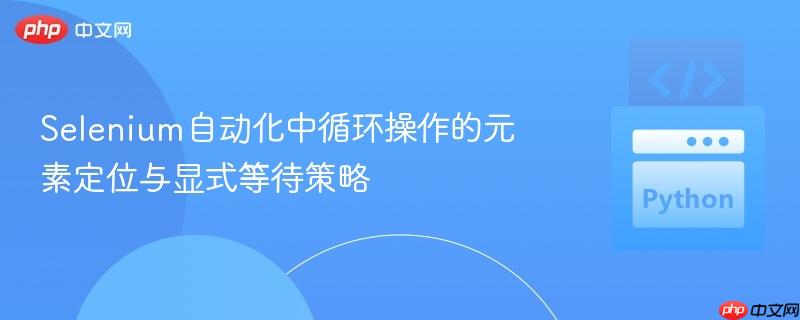
本文旨在解决selenium自动化脚本在循环操作中遇到的“元素未找到”问题,特别是当页面动态加载或导航后。我们将深入探讨隐式等待的局限性,并详细介绍如何通过引入selenium的显式等待机制(`webdriverwait`与`expected_conditions`)来确保元素在交互前处于可操作状态,从而提高自动化脚本的稳定性和可靠性。
在Web自动化测试中,Selenium通过与浏览器交互来模拟用户行为。然而,现代Web应用程序通常是动态的,元素可能不会在页面加载完成后立即出现在DOM中,或者在用户操作(如点击按钮、导航到新页面)后才可用。这导致了一个常见的问题:当自动化脚本尝试与一个尚未加载或不可交互的元素进行操作时,就会抛出“元素未找到”或“元素不可交互”的错误。
在提供的代码示例中,问题描述指出在第一次测试中元素定位正常,但在循环重复执行某些步骤后,却遇到了error encountered: Message: Element {#mat-select-value-1} was not present after 7 seconds!的错误。这通常发生在以下场景:
Selenium提供了两种主要的等待机制:隐式等待(Implicit Wait)和显式等待(Explicit Wait)。
隐式等待:通过driver.implicitly_wait(seconds)设置,它会为WebDriver实例设置一个全局的等待时间。当WebDriver尝试查找一个元素时,如果该元素在DOM中不存在,它会每隔一段时间重新尝试查找,直到超过设定的等待时间或元素被找到为止。问题中的7 seconds提示可能存在一个隐式等待设置。
显式等待:通过WebDriverWait和expected_conditions(EC)模块实现。它允许你为特定的条件设置等待时间,直到该条件满足为止。如果条件在指定时间内未满足,则会抛出TimeoutException。
根据错误信息Element {#mat-select-value-1} was not present after 7 seconds!,问题发生在尝试点击#mat-select-value-1这个元素时。这通常发生在select_first_category函数中。为了解决这个问题,我们需要在点击操作之前,明确等待该元素变得可见且可点击。
以下是使用显式等待改进select_first_category函数的示例:
from selenium.webdriver.support.ui import WebDriverWait
from selenium.webdriver.support import expected_conditions as EC
from selenium.webdriver.common.by import By
from time import sleep # 仅在必要时使用,应尽量替换为显式等待
# 假设 sb 是一个封装了 WebDriver 实例的对象,并且可以通过 sb.driver 访问原始的 WebDriver 对象
# 如果 sb 本身就支持显式等待,请参考其文档进行集成。
# 在这里,我们假设需要直接使用原始的 driver 对象。
def select_first_category(sb):
# 避免使用硬编码的 sleep,用显式等待替代
# sleep(1) # 移除或替换此行
# 定义等待超时时间
wait_timeout = 15 # 例如,等待15秒
try:
# 等待元素 #mat-select-value-1 可点击
# 使用 By.CSS_SELECTOR 定位器
first_category_dropdown = WebDriverWait(sb.driver, wait_timeout).until(
EC.element_to_be_clickable((By.CSS_SELECTOR, '#mat-select-value-1'))
)
first_category_dropdown.click() # 点击下拉菜单
print("First category dropdown clicked successfully.")
# 等待“Application Centre”选项出现并可点击
# 注意:此处假设 span:contains("Application Centre") 是一个有效的CSS选择器,
# 但Selenium原生CSS选择器不支持 :contains()。
# 更稳健的方法是使用 XPath 或根据实际HTML结构调整。
# 示例使用 XPath:
application_centre_option = WebDriverWait(sb.driver, wait_timeout).until(
EC.element_to_be_clickable((By.XPATH, '//span[contains(text(), "Application Centre")]'))
)
application_centre_option.click() # 点击“Application Centre”选项
print("Application Centre option selected successfully.")
except Exception as e:
print(f"Error in select_first_category: {e}")
# 可以选择重新尝试或进行错误处理
raise # 重新抛出异常,以便上层调用捕获
select_second_category(sb) # 继续下一个步骤代码解释:
在Check_Appointment函数中,如果未找到预约时段,脚本会调用go_to_homepage(sb)并重新开始流程。这意味着每次循环迭代,页面都会导航回主页,然后再次执行点击、选择分类等操作。在这种情况下,所有后续的元素定位都需要重新考虑其加载状态。
为了确保go_to_homepage后的重新定位也能稳定进行,同样需要在click_new_booking以及其后续的select_first_category、select_second_category等函数中应用显式等待。
go_to_homepage函数优化建议:
在go_to_homepage函数中,当点击返回主页的链接后,也应该等待主页上的关键元素加载完成,然后再调用click_new_booking。
def go_to_homepage(sb):
wait_timeout = 15
try:
# 点击返回主页的图片/链接
homepage_link = WebDriverWait(sb.driver, wait_timeout).until(
EC.element_to_be_clickable((By.XPATH, '/html/body/app-root/div/header/div[1]/div/a/img'))
)
homepage_link.click()
print("Back to Booking There is No Dates >>>>> Success")
# 等待主页上的某个关键元素加载完成,例如“Start New Booking”按钮
WebDriverWait(sb.driver, wait_timeout).until(
EC.element_to_be_clickable((By.XPATH, '/html/body/app-root/div/div/app-dashboard/section[1]/div/div[2]/div/button'))
)
print("Homepage loaded and 'Start New Booking' button is ready.")
except Exception as e:
print(f"Error navigating to homepage or waiting for elements: {e}")
raise
click_new_booking(sb)Check_Appointment函数的健壮性考虑:
Check_Appointment函数中获取文本也可能因为元素未及时加载而失败。如果sb.get_text内部没有显式等待,也应该添加。
def Check_Appointment(sb):
wait_timeout = 15
no_appointment_message = "no appointment" # 确保此消息与实际页面文本匹配
while True:
try:
# 等待包含预约信息的元素出现并可见
appointment_status_element = WebDriverWait(sb.driver, wait_timeout).until(
EC.visibility_of_element_located((By.XPATH, '/html/body/app-root/div/div/app-eligibility-criteria/section/form/mat-card[1]/form/div[4]'))
)
element_text = appointment_status_element.text # 获取元素文本
if no_appointment_message in element_text:
print("We are sorry but no appointment slots are currently available.")
go_to_homepage(sb) # 重新开始流程
else:
print("Earliest available slot for Applicants")
# playsound('./Music.mp3') # 如果有音频播放,保留
print("Attention Alarm >>>>> Success")
get_appointment_data(sb)
break # 找到预约后跳出循环
except TimeoutException:
print("Timed out waiting for appointment status element. Retrying or navigating back.")
go_to_homepage(sb) # 元素未在预期时间内出现,可能需要重新尝试
except Exception as e:
print(f"An unexpected error occurred in Check_Appointment: {e}")
go_to_homepage(sb) # 发生其他错误也尝试重新开始通过在Selenium自动化脚本中策略性地使用显式等待,可以极大地提高脚本的稳定性和健壮性,尤其是在处理动态Web内容和循环操作时。
关键要点:
遵循这些原则,你的Selenium自动化脚本将能够更稳定地应对各种复杂的Web应用场景,从而减少因元素加载问题导致的失败。
以上就是Selenium自动化中循环操作的元素定位与显式等待策略的详细内容,更多请关注php中文网其它相关文章!

每个人都需要一台速度更快、更稳定的 PC。随着时间的推移,垃圾文件、旧注册表数据和不必要的后台进程会占用资源并降低性能。幸运的是,许多工具可以让 Windows 保持平稳运行。

Copyright 2014-2025 https://www.php.cn/ All Rights Reserved | php.cn | 湘ICP备2023035733号